small description 36 chest
-
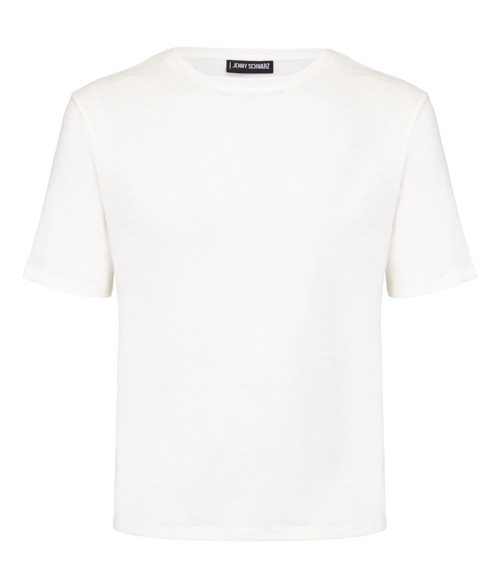
 Merino jersey is the epitome of both luxury and practicality among t-shirts. Merino is a wool that regulates body temperature, wicks moisture away from the body and both insulates and breathes. It is a fine example of how we have forgotten the existing power and inspired creation nature already supplies. The merino sheep that comes, originally from Spain, but more so today from Australia and New Zealand. In the days of Jenny’s great grandfather, adventurous sportsmen like him would have worn woollen base layers and many would have chosen a merino wool due to its inherent qualities.Select options This product has multiple variants. The options may be chosen on the product page Details
Merino jersey is the epitome of both luxury and practicality among t-shirts. Merino is a wool that regulates body temperature, wicks moisture away from the body and both insulates and breathes. It is a fine example of how we have forgotten the existing power and inspired creation nature already supplies. The merino sheep that comes, originally from Spain, but more so today from Australia and New Zealand. In the days of Jenny’s great grandfather, adventurous sportsmen like him would have worn woollen base layers and many would have chosen a merino wool due to its inherent qualities.Select options This product has multiple variants. The options may be chosen on the product page Details -
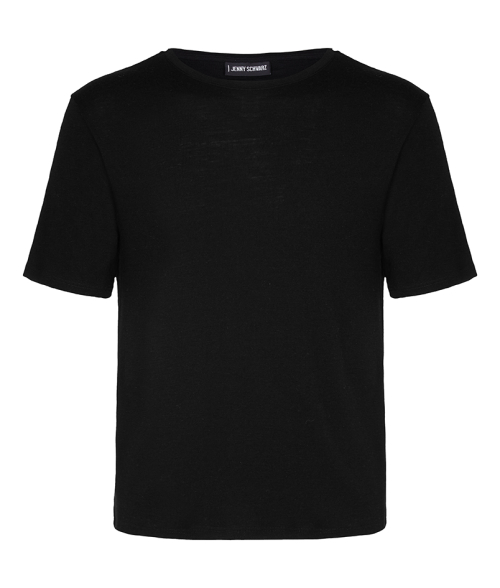
 Merino jersey is the epitome of both luxury and practicality among t-shirts. Merino is a wool that regulates body temperature, wicks moisture away from the body and both insulates and breathes. It is a fine example of how we have forgotten the existing power and inspired creation nature already supplies. The merino sheep that comes, originally from Spain, but more so today from Australia and New Zealand. In the days of Jenny’s great grandfather, adventurous sportsmen like him would have worn woollen base layers and many would have chosen a merino wool due to its inherent qualities.Select options This product has multiple variants. The options may be chosen on the product page Details
Merino jersey is the epitome of both luxury and practicality among t-shirts. Merino is a wool that regulates body temperature, wicks moisture away from the body and both insulates and breathes. It is a fine example of how we have forgotten the existing power and inspired creation nature already supplies. The merino sheep that comes, originally from Spain, but more so today from Australia and New Zealand. In the days of Jenny’s great grandfather, adventurous sportsmen like him would have worn woollen base layers and many would have chosen a merino wool due to its inherent qualities.Select options This product has multiple variants. The options may be chosen on the product page Details -
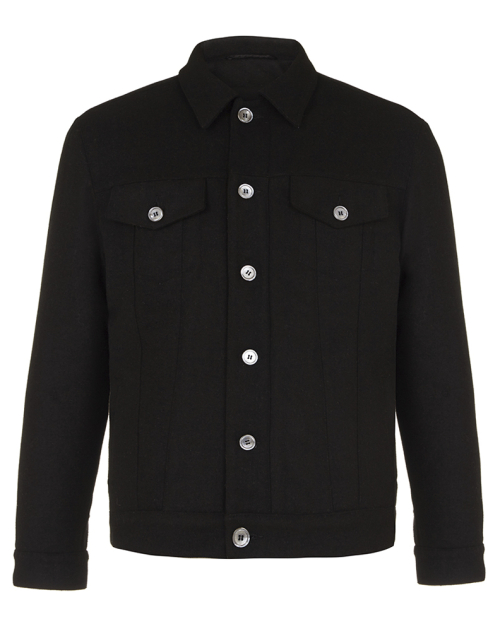

This Nestor jacket is assembled using cloth from one of England’s oldest and historied mills. The black melton wool comes from A W Hainsworth in Pudsey who, among other incredible stories, made the fabric for the Battle of Waterloo soldiers in 1815 and invented the colour Khaki. The cloth itself is a hardy, thick wool with a twill weave. The twill appearance is lost beneath the felted surface texture which is soft to the touch. The short melton fibres allow for a very slight but natural sheen.
We chose a 100% diamond quilted cotton lining to add warmth for colder months.
We offset the enduring wool with black lip mother of pearl buttons. Taken from the troca shell, these dark buttons occasionally catch the light and harmoniously reflect the cloth they sit on.
Black melton is synonymous with the working man’s donkey jacket, while scarlet melton hunting coats have long been a symbol for the upper classes. Its use cases are unsurprising because the cloth is wind and water resistant and very robust. It was intriguing for the same cloth to have connotations with each end of the social scale and pleasant to note that the same properties were enjoyed by both. Our design is utilitarian instead of ceremonial and utterly timeless. The natural light sheen of the A W Hainsworth melton beside the mother of pearl buttons nudge the jacket away from literal work wear.
Select options This product has multiple variants. The options may be chosen on the product page Details -
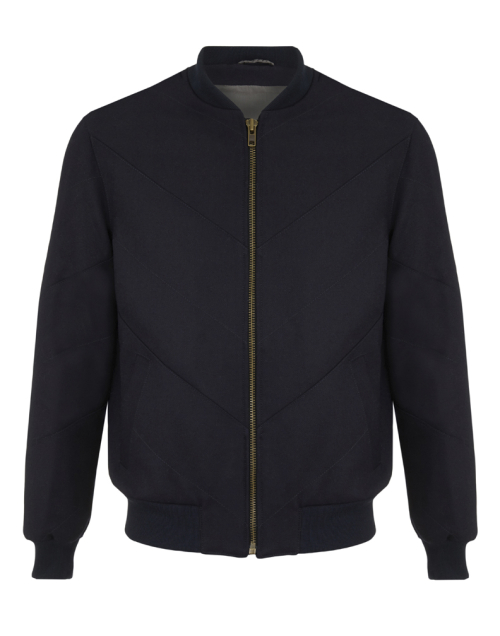
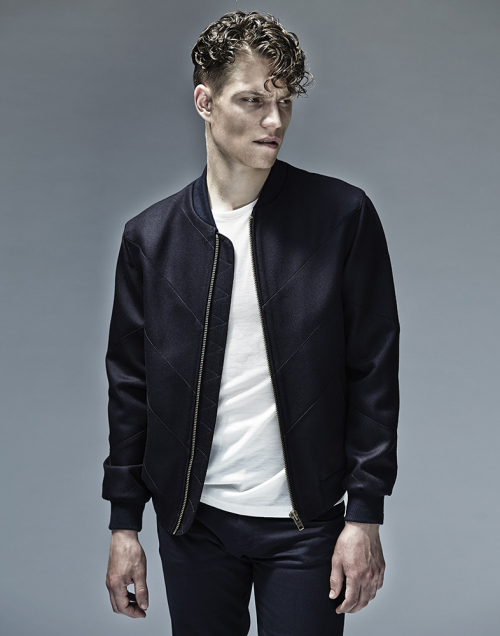
This Francis bomber jacket is assembled using cloth from one of England’s oldest and historied mills. The cloth comes from A W Hainsworth in Pudsey who, among other incredible stories, made the fabric for the Battle of Waterloo soldiers in 1815 and invented the colour Khaki. The cloth itself is a navy barathea wool which holds that slightly textured hopsack weave and is extremely resilient making for a tough but elegant garment that will snap back into shape after wear. It's a lightweight barathea wool giving it more use for a greater part of the year.
This lining is a 100% Viscose Military Twill, an extremely strong and durable lining seen in modern military uniform including the Queen’s Guards. It is made by the 65 year old British lining company, Bernstein & Banleys.
The zip is antique brass in tone with a square ended slider. The metal is neither too shiny like nickel or gold zips and retains a traditional feel.
With worsted barathea wool often employed in the construction of highly formal tailored garments like Dinner Jackets we thought it might play conversely well as one of the most iconic and popular casual jackets, the bomber. The light and natural sheen of the wool lends an air of quality but the most interesting element of the piece is the broken and reformed structure of the pattern pieces creating a chevron paneled effect. Without being too showy the jacket is now individual and intriguing. The stitched lines and and seams where panels meet draw the eye from the centre of the jacket, out towards the shoulder; a technique seen in classic tailoring by the manipulation of peak lapels or the placement of a button.
Select options This product has multiple variants. The options may be chosen on the product page Details -
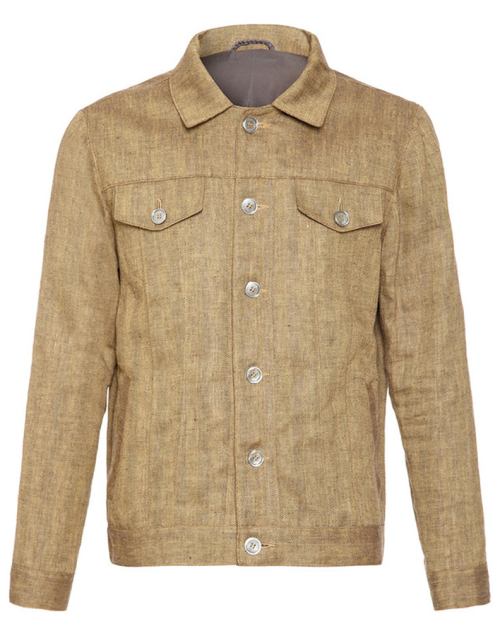

This Nestor jacket is made in a linen and silk blend using a herringbone weave. The result is a textured and interesting jacket with an overall khaki tone. Linen cloth has long been associated with Summer clothing as the fibres have unique properties conducive to hotter weather. Garments made from linen have high air permeability, meaning air can flow quite freely though the woven structure to keep the body cool. It is cool to the touch and breathable and like all linens the fabric holds its wrinkles.
The lining is a 50/50 viscose cupro twill; a high-quality and robust choice from Bernstein & Banleys, a British lining company founded in 1953.
We offset the linen with black lip mother of pearl buttons. Taken from the troca shell, these dark buttons occasionally catch the light and harmoniously reflect the cloth they sit on.
This Nestor jacket is a lightweight, Summer piece good for wearing in hotter climates when you want to look a little more dressed up but don't want the structure or weight of a suit jacket. The wrinkling linen will give the jacket a lived in look while the linen fibres are strong and tough. The slight touch of silk in the blend adds the slightest of natural sheen.
Select options This product has multiple variants. The options may be chosen on the product page Details -
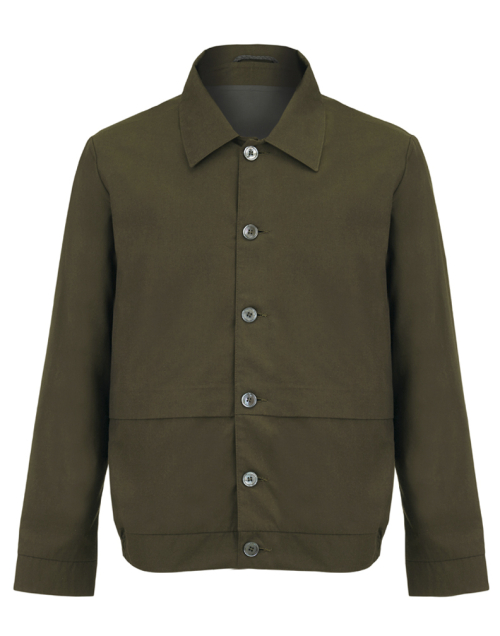

The Belasco jacket is created from a dark green gabardine cotton. The weave is very tight and the treatment of the fibres give it a smooth look with a hint of natural sheen. Gabardine cloth was developed for the trenches of WWI in an effort to replace the heavy wool overcoats that held moisture and dirt rendering them inefficient. Lightweight but strong cotton gabardine proved to be superior and went on to become the foundation of early sport’s clothing. In particular fishing because a wayward hook would not catch on the flat gabardine surface as it would with a fibrous wool.
The lining is a 50/50 viscose cupro twill; a high-quality and robust choice from Bernstein & Banleys, a British lining company founded in 1953.
We offset the quilted cotton with black lip mother of pearl buttons. Taken from the troca shell, these dark buttons occasionally catch the light and harmoniously reflect the cloth they sit on.
This jacket has elements of a blouson with its elasticated waist and looser fit through the waist. The softer tailoring is offset by an inset sleeve giving a structure to the shoulder area. The collar reinforces this idea with its angular rigidity. The front pocket is pleated and acts like an oversized storm pocket with its entry guarded by a welt to prevent rain accidentally dripping inside. The gabardine cotton from which we made the jacket lends a utilitarian slant with a slight but not overtly militaristic lean.
Select options This product has multiple variants. The options may be chosen on the product page Details -
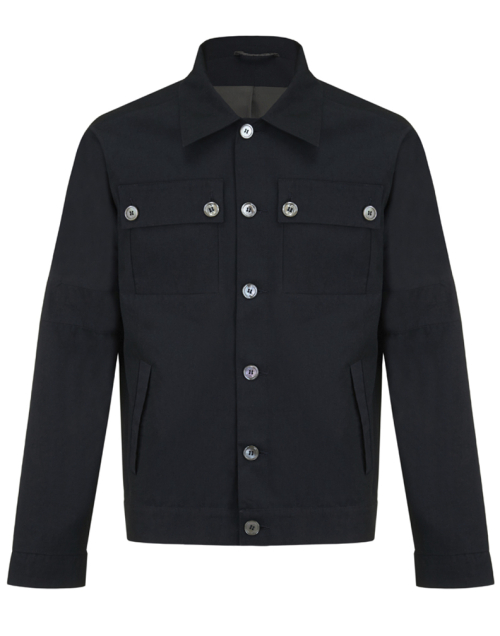
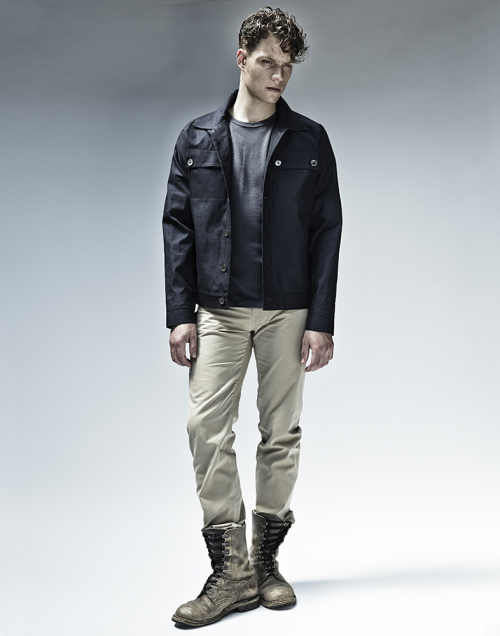
The Madison jacket is created from a navy gabardine cotton. The weave is very tight and the treatment of the fibres give it a smooth look with a hint of natural sheen. Gabardine cloth was developed for the trenches of WWI in an effort to replace the heavy wool overcoats that held moisture and dirt rendering them inefficient. Lightweight but strong cotton gabardine proved to be superior and went on to become the foundation of early sport’s clothing. In particular fishing because a wayward hook would not catch on the flat gabardine surface as it would with a fibrous wool.
The lining is a 50/50 viscose cupro twill; a high-quality and robust choice from Bernstein & Banleys, a British lining company founded in 1953.
We offset the gabardine cotton with black lip mother of pearl buttons. Taken from the troca shell, these dark buttons occasionally catch the light and harmoniously reflect the cloth they sit on.
The Madison jacket is a very forgiving and wearable garment. The strong, durable cotton gabardine lends a utilitarian note to a jacket which is ultimately practical against wind and rain. The shoulder is made soft by the manipulation of pattern panels that run from the neck seam and down the sleeve creating an inverted 'T' shape. Much like a raglan sleeve it follows the shoulder's curves rather than the more defined, angular shaping of an inset sleeve. The top pockets are also of interest as they sit flush with the body rather than sitting on top like a traditional 'patch' pocket.
Select options This product has multiple variants. The options may be chosen on the product page Details -
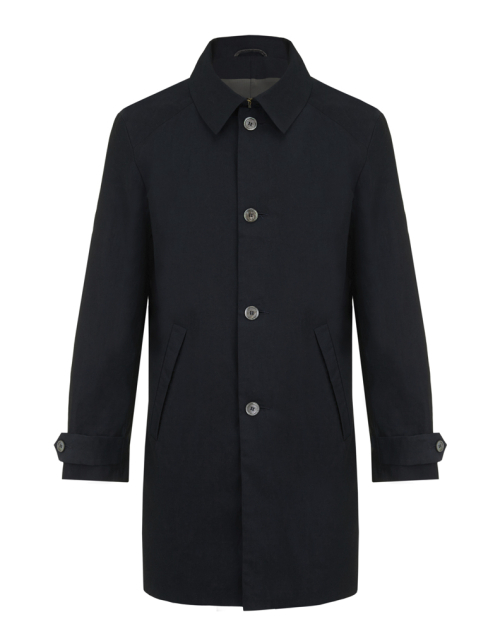
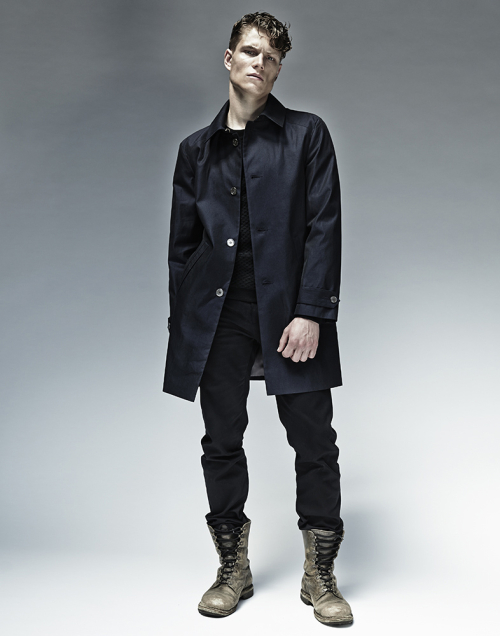
We chose a navy cotton gabardine for this simple raincoat. Gabardine was created as an alternative to the heavy woollen overcoats worn in WWI trenches because it is lightweight, strong, shower proof opposed to the wool coats that would get waterlogged. Gabardine cottons went from being used in war to being used in early sport's clothing, especially fishing as a fishing hook would never get caught in a gabardine cotton jacket unlike its woolen predecessor where it would snag on the loose fibres
The lining is a 50/50 viscose cupro twill; a high-quality and robust choice from Bernstein & Banleys, a British lining company founded in 1953.
We offset the navy cotton gabardine with black lip mother of pearl buttons. Taken from the troca shell, these dark buttons occasionally catch the light and harmoniously reflect the cloth they sit on.
This coat is all about ultimate function and simplicity. Fastening high on the neck with an antique brass clasp and in cotton gabardine it acts as all year-round protection from light showers and moderate winds. It's light enough to be worn over a t-shirt in warmer temperatures but tough enough to guard you in colder climates. The front pockets are storm pockets where a pocket welt overlaps the natural direction of entry keeping contents and your hands drier and out of the elements. Its sharp cut and softly tailored structure enables it to transition from shielding a suit to accompanying denim and trainers.
Select options This product has multiple variants. The options may be chosen on the product page Details -
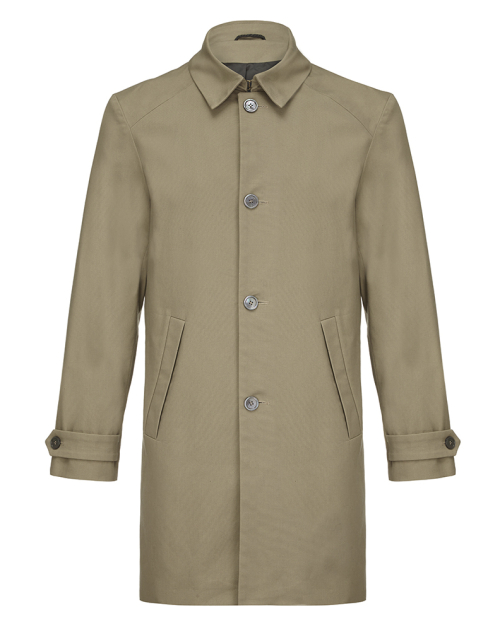
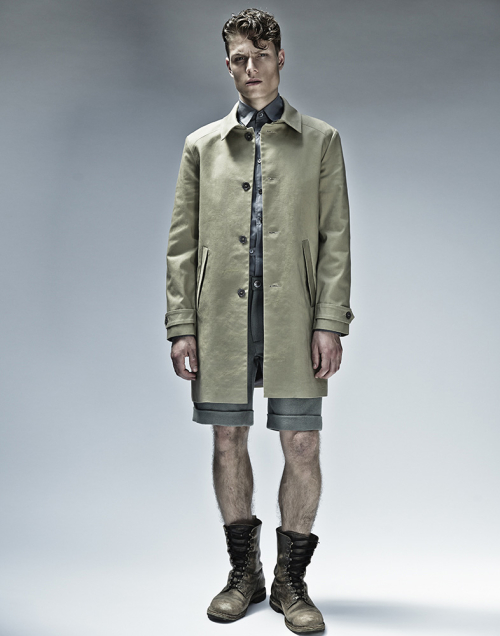
The fabric we chose for this Remi coat is an oatmeal or stone coloured panama cotton. This cloth is very durable and is typically used for creations that need to withstand heavy wear. The tight weave and sturdy construction belie the softness obtained by regular use.
The lining is a 50/50 viscose cupro twill; a high-quality and robust choice from Bernstein & Banleys, a British lining company founded in 1953.
We offset the stone panama cotton with black lip mother of pearl buttons. Taken from the troca shell, these dark buttons occasionally catch the light and harmoniously reflect the cloth they sit on.
This coat is all about ultimate function and simplicity. Fastening high on the neck with an antique brass clasp and in panama cotton it is a seasonless coat suitable for most of the year except high Summer and the coldest Winter days. It is lightweight with the colour particularly suiting Spring and Autumnal outfits. The front pockets are storm pockets where a pocket welt overlaps the natural direction of entry keeping contents and your hands drier and out of the elements. The coat would be better suited to less formal occasions due to the visible weave and the non-traditional colour. But, it would most certainly suit less formal tailoring particularly because of the sharp collar and the inset sleeve.
Select options This product has multiple variants. The options may be chosen on the product page Details -
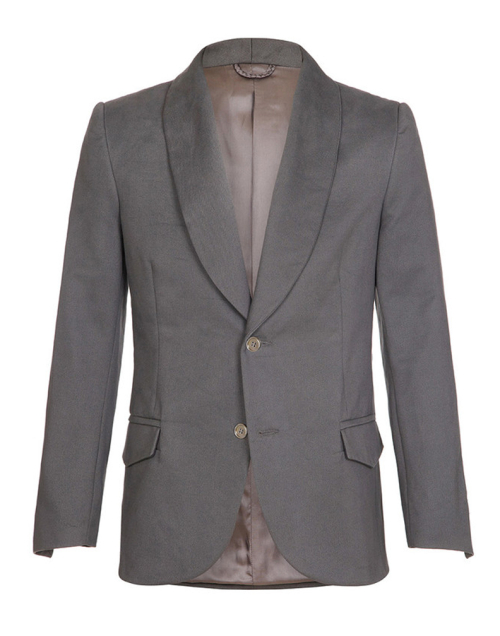

This Marlin jacket is made using a medium grey brushed cotton. Essentially the fibres have been lifted and treated to leave the surface smooth and velvet-like to the touch. This same procedure allows the cotton a very slight sheen and stops the cloth from absorbing light and appearing flat.
The lining is a 50/50 viscose cupro twill; a high-quality and robust choice from Bernstein & Banleys, a British lining company founded in 1953.
We offset the grey brushed cotton with black lip mother of pearl buttons. Taken from the troca shell, these dark buttons occasionally catch the light and harmoniously reflect the cloth they sit on.
The idea behind the grey brushed cotton Marlin jacket is to run that fine line between polar opposites. A formality is introduced in the form of the shawl collar and a ventless hem, both of which are common design features on Dinner Jackets. These ideas work in contrast to the grey brushed cotton, firstly because grey is a colour associated with work suits and cotton is a cloth typical of vintage work wear. In a single design these ideas work harmoniously to create a versatile jacket
Select options This product has multiple variants. The options may be chosen on the product page Details -
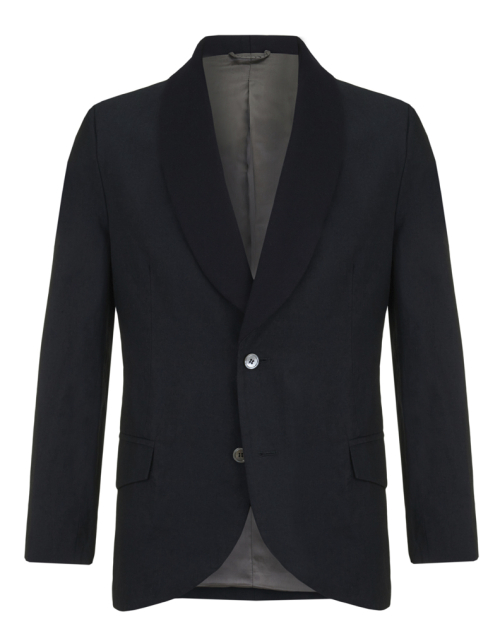

The main body of this Marlin jacket is created from a navy gabardine cotton. The weave is very tight and the treatment of the fibres give it a smooth look with a hint of natural sheen. Gabardine cloth was developed for the trenches of WWI in an effort to replace the heavy wool overcoats that held moisture and dirt rendering them inefficient. Lightweight but strong cotton gabardine proved to be superior and went on to become the foundation of early sport's clothing. In particular fishing because a wayward hook would not catch on the flat gabardine surface as it would with a fibrous wool.
The shawl collar is created with a navy barathea wool from one of Englands most historied cloth mills, A W Hainsworth, who, among other incredible stories, made the fabric for the Battle of Waterloo soldiers in 1815 and invented the colour Khaki.
The lining is a 50/50 viscose cupro twill; a high-quality and robust choice from Bernstein & Banleys, a British lining company founded in 1953.
We offset the navy gabardine cotton with black lip mother of pearl buttons. Taken from the troca shell, these dark buttons occasionally catch the light and harmoniously reflect the cloth they sit on.
The idea behind the Marlin jacket is to run that fine line between polar opposites. A formality is introduced in the form of the shawl collar and a ventless hem, both of which are common design features on Dinner Jackets. These ideas work in contrast to the navy gabardine cotton with its smooth, flat surface and utilitarian history. The A W Hainsworth navy barathea collar lifts the jacket adding some needed texture.
Select options This product has multiple variants. The options may be chosen on the product page Details -
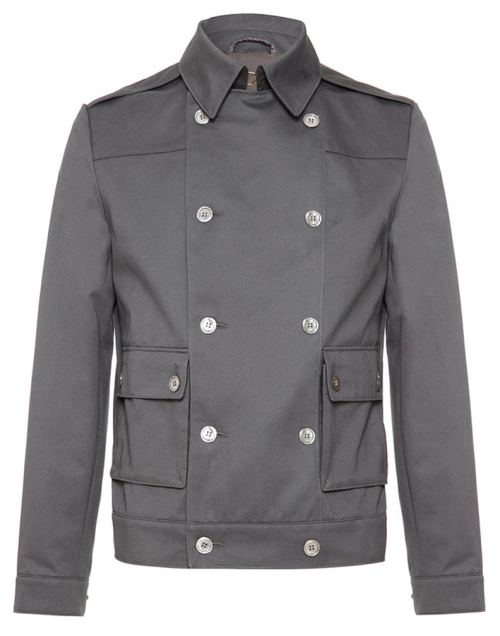
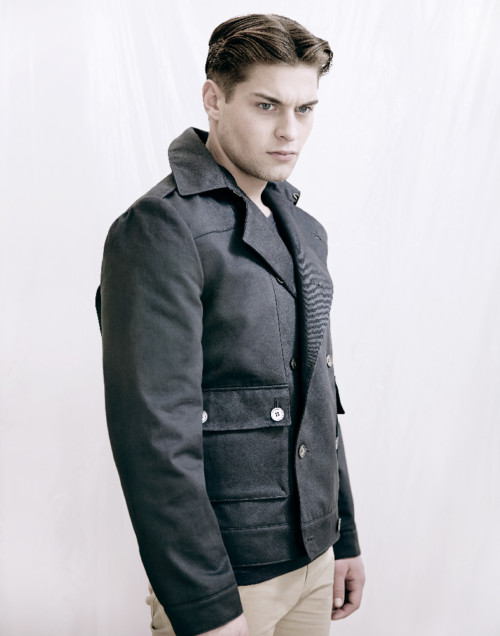
The Thornhill jacket is made using a medium grey brushed cotton. Essentially the fibres have been lifted and treated to leave the surface smooth and velvet-like to the touch. This same procedure allows the cotton a very slight sheen and stops the cloth from absorbing light and appearing flat.
The lining is a 50/50 viscose cupro twill; a high-quality and robust choice from Bernstein & Banleys, a British lining company founded in 1953.
We offset the brushed cotton with black lip mother of pearl buttons. Taken from the troca shell, these dark buttons occasionally catch the light and harmoniously reflect the cloth they sit on.
This Thornhill jacket is a double-breasted military style biker jacket but using an uncommon brushed cotton. There is are pleated panels on the sides at the back to allow extra movement and come practically from allowing a rider to comfortably have their arms raised for longer periods. This was a common trait in sporting jackets and can be seen largely in vintage garments across hunting, skiing and motorcycling.
Select options This product has multiple variants. The options may be chosen on the product page Details